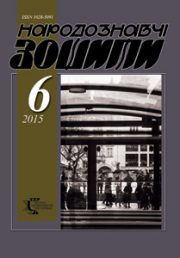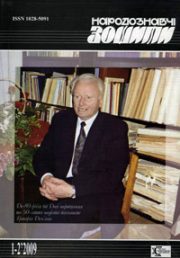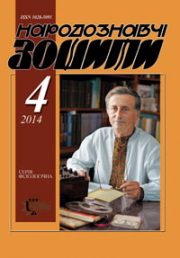The Ethnology Notebooks. 2023. № 4 (172), 1039—1049
UDK 726-523.4:272(477)”15/18″
DOI https://doi.org/10.15407/nz2023.04.1039
URSU Natalia
- ORCID ID: https://orcid.org/0000-0002-2660-2144
- Doctor of Art Criticism, Professor, Fine and Applied
- Arts and Artworks Restoration Department,
- Kamianets-Podilskyi Ivan Ohiіenko National University,
- 61, Ogienko Str., 32301, Kamianets-Podilskyi, Ukraine,
- Contacts: e-mail: ursu@kpnu.edu.ua
HUTSUL Ivan
- ORCID ID: https://orcid.org/0000-0002-4797-5812
- Candidate of Art History, Associate Professor, Fine and Applied
- Arts and Artworks Restoration Department,
- Kamianets-Podilskyi Ivan Ohiіenko National University,
- 61, Ogienko Str., 32301, Kamianets-Podilskyi, Ukraine,
- Contacts: e-mail: hutsul@kpnu.edu.ua
PIDHURNYI Ivan
- ORCID ID: https://orcid.org/0000-0003-0981-2964
- Candidate of Art History, Associate Professor, Fine and Applied
- Arts and Artworks Restoration Department,
- Kamianets-Podilskyi Ivan Ohiіenko National University,
- 61, Ogienko Str., 32301, Kamianets-Podilskyi, Ukraine,
- Contacts: e-mail: pidhurnyy@kpnu.edu.ua
Abstract. The article is a part of consideration of the problem the artistic output of the Dominican order and fills certain lacunae in the history of Ukrainian sacred art. This is an attempt to highlight the metaphorical principles and dimensions that served as the primary source of inspiration during the creation of objects of architecture, sculpture, painting, and decorative and applied arts of the order. The article deals with the general and special semantic features inherent in the spirituality of the preacher brothers, their difference or incorporation with the existing churches of other Roman Catholic orders. The authors, relying on archival materials, analyze the influence of the Divine nature and the Dominican charism on the organization of the external appearance and internal space of the temples of the law, specific examples are given, and information from a significant number of monastic centers in the lands of Ukraine is mentioned and compared.
Keywords: Divine nature, Dominican Order, works of art, metaphors, Ukrainian sacred art, architecture.
Received 6.07.2023
REFERENCES
- Burkhardt, T. (1999). Sacred art of the East and West. Principles and methods. Moscow: Aletheia [in Russian].
- Guenon, R. (1938). The dome and the wheel. Traditional Studies. Paris [in Franch]; (1936). Dante’s Esotericism. Paris [in Franch]; (1957). The Symbolism of the Cross. Paris [in Franch]; (1938). The Symbolism of the Home. Traditional Studies. Paris [in Franch].
- Yatsiv, M. (2003). Reflection of the theological essence of light in the architecture of the Ukrainian church. History of religions in Ukraine. Proceedings of the 13th International Scientific Conference (Vol. 2, pp. 609—615). Lviv [in Ukrainian].
- Kryvoruchko, Iu. (2003). Theological paradigm in the thinking of the creator of the shrine. History of religions in Ukraine. Proceedings of the 13th International Scientific Conference (Pp. 329—339) [in Ukrainian].
- Skibinski. (2004). Architecture of mendicant orders as the implementation of the idea of the New Church. Our Dominicans. Poznan: Poznan Scientific Printing House [in Polish].
- (1823). Kamienets-Podilskyi State City Archives (KPDMA). Roman Catholic spiritual consistory. F. 685. Op. 4. Case № 21. P. 264 [in Ukrainian].
- State Archive of Zhytomyr Region (DAZHO). Visits of the Ovruch Dominican Church for 1821. F. 90. Op. 1. Reference № 467a. P. 2 [in Ukrainian].
- DAZHO. Visits of the Nevirkivskiy Dominican Church for 1819. S. 1. F. 90. Op. 1. Reference № 290. P. 1 [in Ukrainian].
- DAZHO. Visits of the Kamin-Kashirsky Dominican Church for 1823. F. 90. Op. 1. Reference № 538. P. 2 [in Ukrainian].
- Rykvert, J. (1983). Ornament is Not a Crime, Architecture as Art (P. 51). Koln [in German].
- Slobodian, V. (2004). Temples of Rohatynshchyna (P. 205). Lviv: Logos [in Ukrainian].
- Betlej, A. (1998). Building activity of the Jesuits and Pawel Gizycki. Art of the borderland of the Republic of Poland in the modern period from the 16th to the 18th century (P. 266). Warsaw [in Polish].
- Ursu, N.O. (1997). The Golden Section in Composition. Collection of Scientific Works of KPDPU (Vol. 3, p. 62). Kamienets-Podilskyi [in Ukrainian].
- (1839). Russian State Historical Archive in St. Petersburg. F. The Dominican church converted into an Orthodox church in Kozyn. F. 1488. Op. 1. Reference № 644 [in Russian].
- Wolyniak: (M.J. Gizycki), Wolyniak. (1923). List of Dominican monasteries of the Ruthenian province (Vol. 2). Krakow [in Polish].
- Ursu, N.O. (2001). Symbolic-figurative and artistic-compositional features of the sacral plastic of the Dominican church in Kamenets-Podilskyi. Scientific notes. Series: art history, 2 (7), 98—100 [in Ukrainian].
- Szyma, M. (2004). Friezes with a lily motif in Dominican churches in Poland. Our Dominicans (P. 95). Poznan: Poznan Scientific Printing House. Poznan: Poznanska Drukarnia Naukowa [in Polish].
- Grzybkowski, A. (1983). The Present State of Research. Arte Medievale, 1, 143 [in Polish].
- Zaleski, W. (1995, 1923). Fr. Saints for every day (Vol. 2, p. 478).Warsaw; Krakow [in Polish].
- Ursu, N.O. (2000—2001). The interior of the Dominican church in Kamianka on Podilla. Traditions and innovations in higher architectural and artistic education, 6/1, 101 [in Ukrainian].
- Ursu, N.O. (2001). Chapel of Christ the Savior of the Dominican Church in Kamianets-Podilskyi. History of Religions in Ukraine. Proceedings of the 11th International conf. (Vol. 2, p. 388). Lviv [in Ukrainian].






